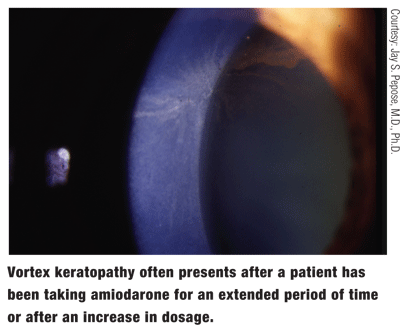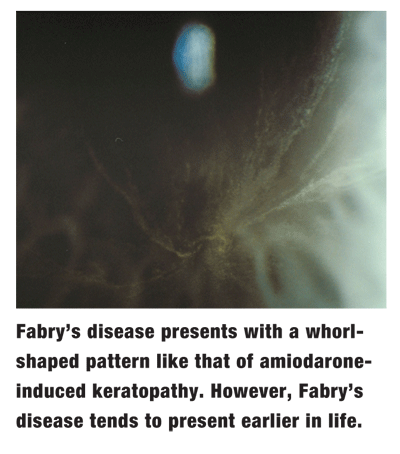 Q: A 72-year-old patient who uses amiodarone for a cardiac condition presented with vortex keratopathy, reduced visual acuity and significant glare. What are the best management options?
Q: A 72-year-old patient who uses amiodarone for a cardiac condition presented with vortex keratopathy, reduced visual acuity and significant glare. What are the best management options?
A: First, contact the patients cardiologist or primary-care physician (PCP). Find out if the medication can be adjusted, says Paul Karpecki, O.D., of
Jay Pepose, M.D., Ph.D., of
 If the comanaging cardiologist or physician is unableor unwillingto modify the patients amiodarone dose, youll have to manage the patients symptoms as best you can. Then, the keratopathy is only going to continue to increase, and the patient will experience more glare and photophobia, Dr. Karpecki says. The patient will have to use protective sunwear and artificial tears to manage it. Unfortunately, thats all you can do.
If the comanaging cardiologist or physician is unableor unwillingto modify the patients amiodarone dose, youll have to manage the patients symptoms as best you can. Then, the keratopathy is only going to continue to increase, and the patient will experience more glare and photophobia, Dr. Karpecki says. The patient will have to use protective sunwear and artificial tears to manage it. Unfortunately, thats all you can do.
In one reported case, a gas permeable contact lens wearer presented with amiodarone-induced vortex keratopathy. Replacing the lenses with ones that incorporate an ultraviolet light inhibitor helped reduce the patients photosensitivity.1
There may be additional reasons for your patients glare and reduced vision. For example, the patient may have corneal edema due to the deposits. That can also cause a lot of the glare and haloes, so it is a common presentation after an increase in medication, Dr. Karpecki says.
Other possible causes: cataracts or dry eye. Amiodarone can also cause anterior subcapsular lens opacities, along with retinopathy and optic neuropathy, Dr. Pepose says.
So, a presentation of vortex keratopathy could signal that some of the more dangerous side effects of amiodarone use may have occurred. Sometimes, youll actually see toxicity in the back of the eye, Dr. Karpecki says. So, you have to make sure that there are no visual disturbances in the back of the eye.
Given this patients age, proceed first with a conservative approach. Consider the patients age, life expectancy and comorbid ocular diseases, such as cataract or maculopathy, Dr. Pepose says.
In extreme cases of vortex keratopathy, superficial keratectomy could be considered an option. Its extreme, but its an option, Dr. Karpecki says. There is no way to stop the deposits but to actually remove the medication or decrease the dosage; and, in the meantime, increase lubrication, he says.
Dr. Pepose agrees. Surgical options are rarely needed, although patients sometimes complain of haloes or colored rings at night, he says.
Q: How do I differentiate vortex keratopathy from other conditions that present similarly? A: Conditions that have a similar presentation include stem cell deficiency and Fabrys disease. Stem cell deficiency is certainly another possible cause that, at that age, you want to be looking out for, Dr. Karpecki says. Fabrys is the other one that you have to be careful about, but that usually manifests earlier.
A: Conditions that have a similar presentation include stem cell deficiency and Fabrys disease. Stem cell deficiency is certainly another possible cause that, at that age, you want to be looking out for, Dr. Karpecki says. Fabrys is the other one that you have to be careful about, but that usually manifests earlier.
In amiodarone-induced vortex keratopathy, the drugs or drug-metabolites bond with cellular lipids within lysosomes. These are either resistant to enzymatic degradation or passage from the lysosomes, which leads to lysosomal inclusions, Dr. Pepose says. The whorl-shaped pattern of brown or golden-brown deposits may reflect the centripetal migration of deposit-laden epithelial cells.
Other medications may cause a presentation similar to that following use of amiodarone. A host of cationic amphiphilic drugs, such as chloroquine, tamoxifen, suramin and clofazimine, may also result in a drug-induced lipidosis and produce a vortex keratopathy, Dr. Pepose says. This vortex pattern has been reported with some very common drugs, such as ibuprofen and indomethacin, he adds.
Atovaquone and isotretinoin are other drugs that may cause such a keratopathy, two separate studies found.2,3 This is also due to the lipophilic properties of both drugs.
You can also differentiate between drug-induced vortex keratopathy and other causes by modifying the patients medicine regimen and monitoring the results. Once the amiodarone is stopped, the vortex will remain if its due to stem cell deficiency, Dr, Karpecki says.
But, if the vortex is a result of the patients amiodarone regimen, the deposits will decrease. The drug-related forms of vortex keratopathy generally resolve with discontinuation of the medication, says Dr. Pepose. Resolution can take from three until 20 months after stopping the amiodarone.
1. Astin CL. Amiodarone keratopathy and rigid contact lens wear. Cont Lens Anterior Eye 2001;24(2):80-2.
2. Shah GK, Cantrill HL,
3. Fraunfelder FT, Fraunfelder FQ, Edwards R. Ocular side effects possible associated with isotretinoin usage. Am J Ophthalmol 2001 Sep;132(3):299-305.

